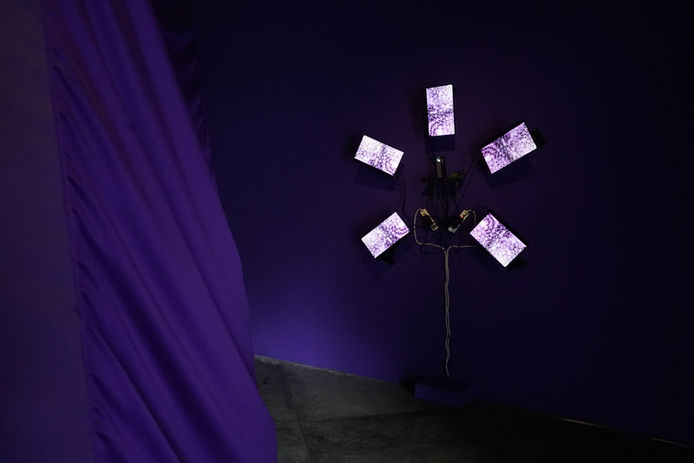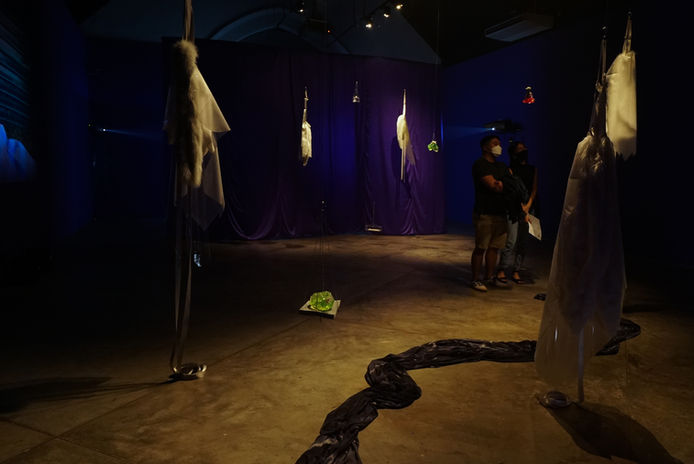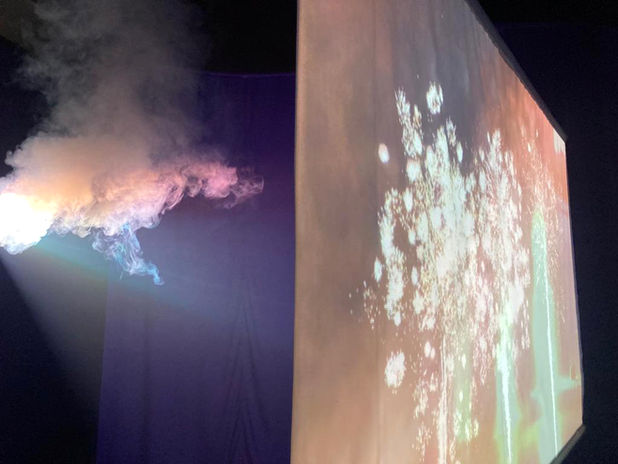immaterial bodies
Curator (Recipient of Objectifs Curator Open Call 2020)
Objectifs Centre for Photography and Film
3 September - 1 November 2020

Extending a thread of inquiry situated between the material world of things and the immaterial world of affects, immaterial bodies weaves together the works of Weixin Quek Chong, ila, Wayne Lim and Denise Yap. Through varied approaches, they explore how bodies respond to and are affected by different encounters, serving as conduits for affective responses and surfacing new possibilities of existence and relationships, ideas which are especially relevant in a world made more precarious, anxious and chaotic in light of Covid-19's global impact.
The works of the artists in the exhibition probe four areas: the memory of the body in relation to shifting urban landscapes; systems of control over the citizen body; morphings and transformations of the post-human body; alternative kinships and possibilities of being. The exhibition questions: can we speculate on the potential of artworks as disobedient agents to generate affect that sits (in-between, beside, under, behind, next to, alongside...) the prescribed, rational world? How can affect be a way to resist controls and trace the emotional contours of life during increasingly precarious times? How have previous notions of bodily relations, distanced encounters, and forms of collectivity and exchange transformed in a post-pandemic climate?
immaterial bodies, curated by Seet Yun Teng is the recipient of Objectifs Curator Open Call 2020, an annual programme that encourages innovative curatorial approaches to lens-based art by giving emerging curators an opportunity to realise an exhibition with professional and financial support.
Artwork Descriptions
Xafier Yap (previously Denise Yap), Miss Q (2020), video, screens, wires, circuitry, projection
Part of a long-term speculative fiction piece that Yap is writing titled New Growth, Miss Q belongs to a future in which alternative kinships, non-nuclear families and gender fluidity is accepted.
In the world of New Growth, in rejection of capitalist (re)production and environmental extractivism, the queering of our relationship to other beings and the world generates different kinships which are intimate, emergent and interconnected. As artefacts of the writing, their artworks manifest ideas and experiences that language is unable to fulfil. In this future, the artist imagines rhizomatic, web-like relationships, and harnesses the technological embodiment of the orchid, itself representative of eugenic hybridity, marginal selfhoods and national narratives. Here, the orchid is re-germinated as a set of monitors, each standing in for a petal.
Bypassing bodily matter to approach a moving, technological membrane, Miss Q offers a fluid, immaterial, and sensory proposition of being, one that is quietly optimistic and empowering.
ila, hancur badan dikandung tanah (2020), video
hancur badan dikandung tanah is a new moving image work that continues the artist’s interest in the relationship of the human body to the places we inhabit, a city characterised by disappearing sites of memory, both personal and collective.
Intersecting the body with barricaded construction sites within the city, ila questions the impact of constant erasure that has become normalised – where buildings, streets and other physical spaces that we used to occupy cease to exist. What are the consequences of the precarious relationship of urban progress with our own lived experiences, memories and existences? What disappears and what remains? “hancur badan dikandung tanah” references a Malay proverb that translates to the body which is contained by land, disintegrates to the ground... What layers of ourselves are removed when we no longer are able to come back to the places we grew up in, the schools that we went to, the houses in which we lived?
Taking a visual reference from sound barrier fabrics covering facades of demolition and construction, they blow in the wind, mapping, enveloping and evoking the immaterial body. This tender performative work shifts between abstract shifting surfaces to recognisable bodily contours that struggle against the tarpaulin. Further overlaid are responses collected from the general public, whose narratives and memories intersect in a poignant reflection on the presence of absence.
Weixin Quek Chong, larval limbic (2019), installation, soft sculptures, objects and sound
larval limbic forms a new direction of work by Weixin Quek Chong that is concerned with themes of morphing and transformation, with influences from fashion, evolution and body modifications.
Centred around an installation of objects, printed textiles and audio, it thinks about the evolution of the appearance and presentation of bodies, imagining possibilities of reflecting gender fluidity and post-humanness. Its main references come from science fiction author Octavia Butler and the orchid mantis, an insect which has adapted to resemble orchids in what is known as ‘aggressive mimicry’. Butler’s writing in her post-apocalyptic series Lilith’s Brood describes a world where humanity struggles to adapt itself to its new environment by merging with alien species and taking on new forms.
The artist is intrigued by the drastic transformations insects such as the orchid mantis undergo, and imagines it as a model for a possible hybrid being. The sound of larval-stage creatures transitioning into their proximate form is central to this piece, and adds another layer of affective register to the experience of the work. They invite a range of material encounters that evade expectations and rationalising impulses.
Wayne Lim, The Hyperrestrained Order (2020), 2-part audio-visual installation, smoke machine, neon light
The Hyperrestrained Order (HRO) is a 2-part audiovisual installation that examines the symbolism and mechanisms of discipline and control in Singapore. It builds on Lim’s research into the “hyperrestrained order”, a concept that integrates theorists Michel Foucault’s disciplinary society, Gilles Deleuze’s societies of control, and the hyperreal image of the photogenic, spectacle-centred state.
From the perpetuality of a statist education, to culturally and militaristically coded semiotics, and finally everyday corporate language, The Hyperrestrained Order unpacks the systematic organization of time-space and the reproduction of social relations through the mobilization-and-mobility of citizen bodies. These time-spaces are the enclosures of schools, the military camps, the offices, and the mall complexes, between which individual bodies move seamlessly in order. The infrastructural state of motion, capital, goods, time, money, people, and so on, runs in parallel to the concept of mobility in enclosed spaces. Over time, the social engineering of such conditions form a society that crystallises narratives surrounding national identities, cohesion and collective experiences.
Ultimately, this condition reveals the deprivation of the exercise of (aesthetic) imaginations against state/economic/ideological regimes — a crisis of imagination. In this sensory and experiential installation, a question is explored: can the symbolic act of aesthetic disobedience be turned into strategic use of time in a hyperrestrained society?
Microsite
The physical exhibition was accompanied by a microsite www.immaterialbodies.objectifs.com.sg which featured additional artistic entanglements, commissioned writing responses, special artist videos introductions, the curatorial essay and educational exhibition guide. These sought to supplement the exhibition experience yet not replace it, but provide alternative points of entry into the exhibition. It was also designed for both effective desktop and mobile viewing experiences.
Entanglements (Digital Activations)
Entanglements brings together and generates connections between the various materials in immaterial bodies. The idea of entanglement is that it is “a relation, an affectivity, a feeling between us: my life may affect yours, but what happens to me does not fully determine what happens to you; nevertheless, we are entangled.”
(Lindsey Andrews, From Inside a Black Box, Lute & Drum 8, 2016).




Curatorial Essay
Programmes
3 Sept 2020 – Extended Opening & Guided Tour
18 October 2020, 12pm – 6pm – Tactility Studies: Pandemic Distances
An immersive workshop experience presented as part of immaterial bodies.
When was the last time you touched someone other than people in your household, or your family?
2020 has been a peculiar year of minimised human touch, rapid digitalisation, and a pervasive air of uncertainty as the world recalibrates around an unseen virus. In these times, we protect one another by not-hugging, bumping elbows, and trying as far as possible not to breathe the same air. What then are options that do still remain for us to touch? In the durational work Tactility Studies: Pandemic Distances, we sensitise the soles of the feet, and play with gestures of self-care in public space – in persistent hope of expanding the current choreographies of touch and connection.
Tactility Studies: Pandemic Distances is based on Tactility Studies, a performative project jointly manifested by Chong Gua Khee and Bernice Lee, theatre and dance artists who have been collaborating since 2016. In Tactility Studies, they invite people to open up their bodies as sites and spaces for performance – to be soft, to wobble, to uncoil. Paying attention to how touch can be both transgressive and reparative, Tactility Studies desires to generate new affective discourses around platonic, pleasurable, safe touch and consent. Tactility Studies has been incubated at and supported by Dance Nucleus since 2018. For more information visit: fb.com/TactilityStudies
Curator’s Note:
The ideas and intentions of Tactility Studies align strongly with this exhibition, and they are invited to be part of the public programme for immaterial bodies. In light of the pandemic crisis and the indelible traces it has left on our social and bodily behaviours, Tactility Studies has evolved as an emergent and responsive effort to present, Tactility Studies: Pandemic Distances.
Co-directors: Chong Gua Khee and Bernice Lee
Production Manager: Lam Dan Fong
Dramaturg: Corrie Tan
Performers: Habibah Mohckeram + Adele Goh
Visual/Set Design: Habibah Mohckeram
Music/Sound Design: SAtheCollective
Credits
Presented by | Objectifs Centre for Photography and Film
Supported by | National Arts Council, Tote Board Arts Fund
Artists | Weixin Quek Chong, ila, Xafier Yap, Wayne Lim
Contributors (Entanglements) | Ang Kia Yee, Soh Kay Min
Programme Partner | Tactility Studies
Design | Currency
Photo/Video Documentation | Third Street Studio
























